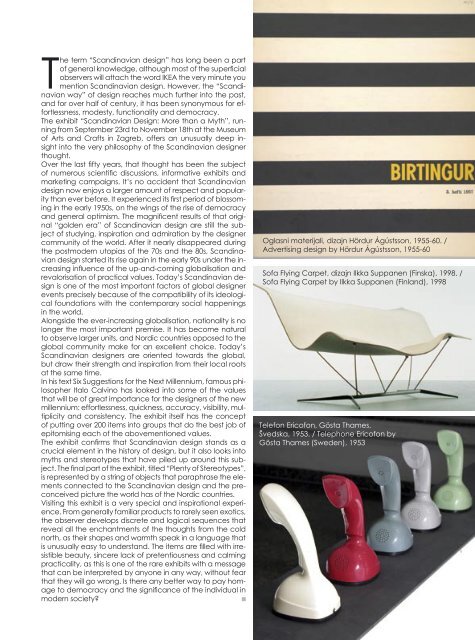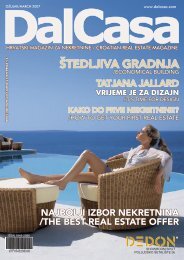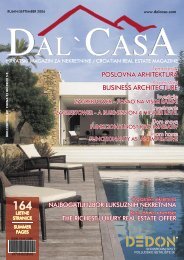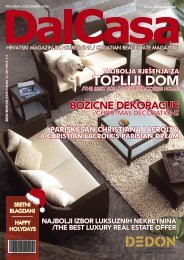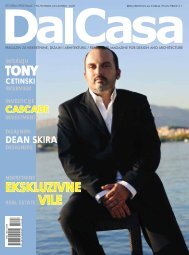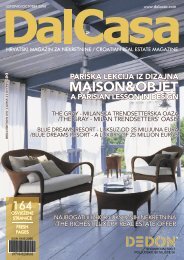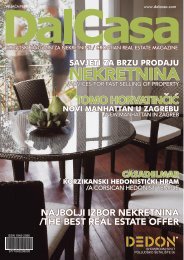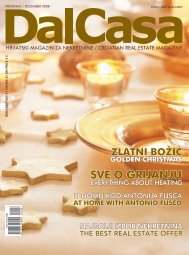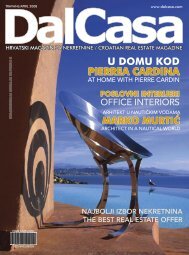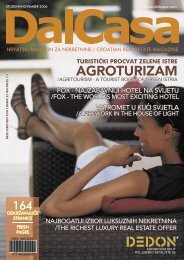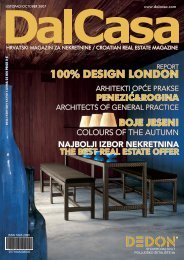ROBERT SEVER CELEBRITYJI - DalCasa
ROBERT SEVER CELEBRITYJI - DalCasa
ROBERT SEVER CELEBRITYJI - DalCasa
You also want an ePaper? Increase the reach of your titles
YUMPU automatically turns print PDFs into web optimized ePapers that Google loves.
The term “Scandinavian design” has long been a part<br />
of general knowledge, although most of the superficial<br />
observers will attach the word IKEA the very minute you<br />
mention Scandinavian design. However, the “Scandinavian<br />
way” of design reaches much further into the past,<br />
and for over half of century, it has been synonymous for effortlessness,<br />
modesty, functionality and democracy.<br />
The exhibit “Scandinavian Design: More than a Myth”, running<br />
from September 23rd to November 18th at the Museum<br />
of Arts and Crafts in Zagreb, offers an unusually deep insight<br />
into the very philosophy of the Scandinavian designer<br />
thought.<br />
Over the last fifty years, that thought has been the subject<br />
of numerous scientific discussions, informative exhibits and<br />
marketing campaigns. It’s no accident that Scandinavian<br />
design now enjoys a larger amount of respect and popularity<br />
than ever before. It experienced its first period of blossoming<br />
in the early 1950s, on the wings of the rise of democracy<br />
and general optimism. The magnificent results of that original<br />
“golden era” of Scandinavian design are still the subject<br />
of studying, inspiration and admiration by the designer<br />
community of the world. After it nearly disappeared during<br />
the postmodern utopias of the 70s and the 80s, Scandinavian<br />
design started its rise again in the early 90s under the increasing<br />
influence of the up-and-coming globalisation and<br />
revalorisation of practical values. Today’s Scandinavian design<br />
is one of the most important factors of global designer<br />
events precisely because of the compatibility of its ideological<br />
foundations with the contemporary social happenings<br />
in the world.<br />
Alongside the ever-increasing globalisation, nationality is no<br />
longer the most important premise. It has become natural<br />
to observe larger units, and Nordic countries opposed to the<br />
global community make for an excellent choice. Today’s<br />
Scandinavian designers are oriented towards the global,<br />
but draw their strength and inspiration from their local roots<br />
at the same time.<br />
In his text Six Suggestions for the Next Millennium, famous philosopher<br />
Italo Calvino has looked into some of the values<br />
that will be of great importance for the designers of the new<br />
millennium: effortlessness, quickness, accuracy, visibility, multiplicity<br />
and consistency. The exhibit itself has the concept<br />
of putting over 200 items into groups that do the best job of<br />
epitomising each of the abovementioned values.<br />
The exhibit confirms that Scandinavian design stands as a<br />
crucial element in the history of design, but it also looks into<br />
myths and stereotypes that have piled up around this subject.<br />
The final part of the exhibit, titled “Plenty of Stereotypes”,<br />
is represented by a string of objects that paraphrase the elements<br />
connected to the Scandinavian design and the preconceived<br />
picture the world has of the Nordic countries.<br />
Visiting this exhibit is a very special and inspirational experience.<br />
From generally familiar products to rarely seen exotics,<br />
the observer develops discrete and logical sequences that<br />
reveal all the enchantments of the thoughts from the cold<br />
north, as their shapes and warmth speak in a language that<br />
is unusually easy to understand. The items are filled with irresistible<br />
beauty, sincere lack of pretentiousness and calming<br />
practicality, as this is one of the rare exhibits with a message<br />
that can be interpreted by anyone in any way, without fear<br />
that they will go wrong. Is there any better way to pay homage<br />
to democracy and the significance of the individual in<br />
modern society?<br />
Events<br />
Oglasni materijali, dizajn Hördur Ágústsson, 1955-60. /<br />
Advertising design by Hördur Ágústsson, 1955-60<br />
Sofa Flying Carpet, dizajn Ilkka Suppanen (Finska), 1998. /<br />
Sofa Flying Carpet by Ilkka Suppanen (Finland), 1998<br />
Telefon Ericofon, Gösta Thames,<br />
Švedska, 1953. / Telephone Ericofon by<br />
Gösta Thames (Sweden), 1953<br />
37


